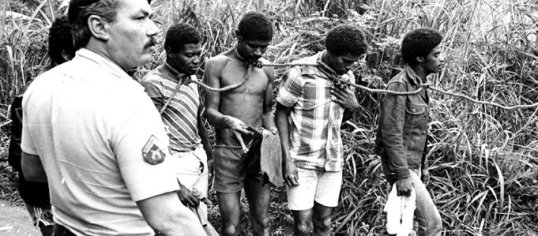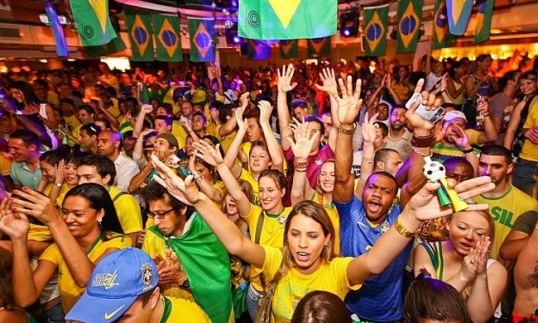Lost Sambista
A Brazil never seen.
Archive for the month “January, 2014”
Brazilian Carnival – 1970’s
A short film by Rodrigo Amarante editing together his family’s Super-8 films shot during a Carnival in Saquarema in the 1970’s.
A great illustration about what Lost and what Samba.
Lost Samba – Chapter 19/01 – Brazil’s musical wizards.
The final year at the Colégio Andrews was completely different to the previous ones and one hundred percent directed at preparing us for the ultimate exam. The classes were in a separate building with the students grouped into four classrooms – two for earth sciences, one for biomedicine and one for the humanities. I had chosen the latter. By now, school was pure stress. The methods were intense with teachers bombarding us with infallible secrets to jump over the massive hurdle that was the Vestibular.
Our schools’ programme had a good reputation, and students transferred there from other institutions in Rio as well as from further afield. One of the new students had come from Chile. Kristof was of German descent and resembled the actor Jack Palance, albeit with long blonde hair. A few days after school began; Kristof and I took the usual bus home and started chatting. For some reason, the conversation turned to Teresópolis and we discovered, to our absolute amazement, that we were next-door country house neighbours in the Jardim Salaco. This was a massive coincidence and it helped to make us instant best friends.
We had more things in common: Kristof was also into music and played the transversal flute (he was to become a professional saxophone player), he also had a European edge and in some inexplicable way we both managed to stay academically in the top quarter of the student body despite being members of the “smoke squadron”. Kristof had come to Rio to live with his dad and, after he joined the music circuit, his flat on a hill at the end of Leblon became the new headquarters of our small brotherhood of musical misfits.
Although for us the rock giants of the 1970s still reigned supreme, we were also into jazz-rock represented by a generation of brilliant musicians such as John McLaughlin’s Mahavishnu Orchestra, Focus, Jean-Luc Ponty, Jeff Beck, Stanley Clarke and Weather Report. As was the case with so many aspects of Brazilian life and youth culture, we were some five years behind what was happening in Britain and North America and were still completely oblivious to the existence of both punk and reggae. Anyhow, I suspect that even if we had known of these developments, as aspiring musicians, we still would have stayed tuned into those great instrumentalists.
There was also new high calibre local musical talent emerging and our ears were ripe for musicians like Hermeto Pascoal, Nana Vasconçelos and Egberto Gismonti who seemed to be a conduit for the kind of energy I had experienced in the south of Bahia. If Bossa Nova had been a reflection of Brazil’s post-war optimism, this new musical generation reflected a moment of self-discovery and of rebirth emerging from the resurgence of political freedom. Despite being exclusively instrumental these musicians were popular, their concerts attracted respectable large crowds, and for a short while they were the top selling acts amongst the educated middle class.
Of the three, Egberto was my favourite. His talent first became apparent in his father’s musical instrument shop where he demonstrated pianos to customers. As a young adult, Egberto went to France to study classical music. When he returned to Rio, he applied his acquired knowledge and his genius to Brazilian music, going way beyond Bossa Nova. Arguably, Egberto Gismonti became as significant a musician as Heitor Villa-Lobos, Brazil’s greatest classical composer. Among other things, Egberto was unique in experimenting with indigenous music, going as far as to learn sacred music from a shaman in the Xingu area. The story goes that for Sapaim, the musician/shaman, to accept him, Egberto had to camp outside his jungle longhouse for about a month until he was invited in. Perhaps because of what he learned there, the sounds in Gismonti’s concerts were hypnotic, almost like a solid entity, with audiences always giving their absolute attention.
Hermeto Pascoal was born in the remote and dry interior of the Brazilian Nordeste – the Sertão. As Hermeto was an albino, he couldn’t work under the scorching sun, so his brothers would lock him up in a barn where he channelled his fury and energy into music. Hermeto’s long and curly white hair and beard, and his strong facial features covered by thick glasses, lead to the deserved nickname of ‘the Sorcerer’. His band made insane noises, not only with instruments, but also with everyday objects such as broken bottles, saws and pans. In the midst of this madness, however, there was genius, with valleys of heavenly music brewed from the mysteries of the Indigenous, the Africans and the Europeans.
Of the three instrumentalists, the one with the greatest international success was Nana Vasconcelos. The magazine Down Beat, the most important one in the Jazz world, was to elect him eight times as the best percussionist in the world; he also was to receive eight Grammy awards. Being from Pernambuco and the only African descendant of the three he had a close attachment to the spiritually charged Maracatu rhythm. Perhaps due to both he took percussion to previously unimaginable psychedelic heights.
Egberto, Nana and Hermeto were by no means the only expressions of Brazilian instrumental and experimental music in the late 1970s early 1980s. There were also bands such as Uakti – known for using custom-made instruments, made by members of the group themselves – the name derived from a native Tucano myth of a man/instrument. There were also the more electrical bands such A Cor do Som and the guitarist Pepeu Gomes, both offshoots of the Novos Baianos. Anyhow, after their relatively brief popularity in Brazil, the three main exponents of their generation would fall out of fashion at home but would emerge as stars on the international jazz scene.
Brazil’s 1970 Campaign
All about probably the best campaign ever in a world cup.
Lost Samba – Chapter 18/03 – In Brazil’s Holy of Holies
The early morning sun breaking through the cracks in the window’s shutters woke me up. I could still hear the wind but now it was gentler, enabling me to also hear the sound of bird songs and the soothing rhythm of waves breaking in the distance. Daylight revealed pristine nature preparing for the new day. At that moment, the world consisted of just my hut, the surrounding forest, a deserted beach and me. The temperature was agreeable and that unique moment of peace in that special place, transported me to the beginning of time.
I was not very far from where history books say that the Portuguese had first set foot on that uncharted land. This was the spot where those western lost souls had officially planted the seeds of a new country. I walked to the sea and had a long swim. In the deep I floated in the calm, crystal-clear, water. At that moment, at that place, it was easy to imagine the first flotilla appearing from beyond the horizon. Was anyone on those ships considering anything other than plundering what lay beyond the beach? Was the exotic jungle a soul devourer, or a place waiting to be tamed? Could the intruders possibly have imagined that there was anything worthy of their respect or to learn from in this beautiful place and from its original inhabitants?
*
Before the arrival of hippies, Trancoso had been a Christian mission for the conversion of the indigenous Pataxó people. All that remained of that time was the simple parish church that faced inland and a group of westernized descendants of that tribe who lived in a reserve a few kilometres away. Its back faced the ocean and it was there where we gathered every night when the church’s whitewashed wall reflected the strong moonlight like a screen in a movie theatre. Long before the arrival of the first white men, the local tribe assembled at this very spot for festivals. The sacred ground still held its power with Trancoso remaining a place apart. The only trace of civilization anywhere around was Porto Seguro twenty to thirty kilometres away, its lights faintly visible on the far corner of the horizon.
We waited for the full moon and, after an hour or so, a huge silver ball started rising up at the end of the ocean. We were around ten people, gazing at that apparition in awe and in silence. The reflection grew stronger and created a bright streak across the water. The moon rose above the low clouds making them look like white, puffy, backlit mountains, casting heavy shadows from only a few meters above the sea. Their bases were flat, as if a meticulous artist had sliced them.
While I contemplated that marvellous scene, the universe sent a vision showing me that love, life, health, the water we drank, the air we breathed, were all for free. We were not on a different planet, nor was this a dream: all that magic could be here and now, forever, if only we would learn how to value the things that were given to us. I wished Trancoso would always be my home and that the feeling of completeness never ended.
*
Those last three weeks passed in the blink of an eye and all too soon it was time to return to the reality of city life. I bummed a lift to Rio with some guys who were returning home to São Paulo. Unbelievably, they had managed to reach Trancoso driving their beetle along a dirt track through the forest. I had never heard about the trail and, after a few minutes in it, they remembered that this was not a route intended for cars. Thick vegetation must have sprung up since they had first driven along that track because we kept on having to get out of the old Volkswagen and push it through mud and over the tangle of plants. It took a couple of hours until the trail developed into something more resembling a dirt road. Eventually this got wider, and soon cattle, donkeys and small huts started to appear and eventually, people sitting by stands selling local fruit. Finally, we came across cars and after we passed by Ajuda and arrived at the barge that crossed over to Porto Seguro there was a small queue of cars waiting to board. On the other side there was already asphalt and the highway that took us on the long journey home.
I arrived back in Rio under the spell of Bahia. It was difficult to face the fact that a crucial battle of university entry exams lay ahead. There was another zone of contention ready to erupt at any moment; with every joint I rolled, with every jam session I participated in, with every new friend I made, I was immersing myself further into a world that my parents could not even begin to understand. A process of becoming completely estranged from my family was on its way. Mum and Dad were at a loss, not having a clue as to what was going on inside my mind and my soul. I had taken their quest for the New World many steps beyond their imagination. I was entering a no man’s land where, on the one hand, I was distancing myself from my roots and, on the other hand, those very roots made me structurally different to the people, and to the culture, I was relating to.
My parents expected Sarah and I to accept without question the terms of their happy adventure in the idyllic land that they had chosen. Now that we had grown up, the cultural baggage they had brought over from the Old Continent paralysed their reactions towards our experiences. The British way was to brush everything under the carpet, not to discuss problems in the hope that things would sort themselves out in one way or another. The central European approach was more pragmatic, but disregarded the poetry of life: searching one’s truth was pointless and bad for business – the solution was simply a matter of getting my head down and doing the right thing: studying. From my side, the process of making sense of the situation that I was born into would require a rupture, and, by the looks of it, this process would be solitary and painful.
Brazil-Africa magic
What happens when you get the best of Brazilian rock in the eighties and take them to Mali?
The on-line home of Bossa Nova
Sometimes the internet surprises us. We tried to search a site about Brazilian culture in English and found out that there were very few written by non-Brazilians. There was one heart warming exception: bossanovamusic.com. As the name suggests this is a site dedicated to our favorit style of music. We were happy to find a passionate account of the history of Bossa Nova, articles about its main exponents, interviews with Bossa Nova artists, excerpts of news about Bossa Nova throughout the world, reviews on albums and on related publications, everything done with great quality and care.
We got in touch with the guys and asked them to tell us more about the site. The answer was:
“… Bnovamusic.com is a site run by a group of fans that are passionate about bossa nova and its culture. Wanting to delve in further than just the music we decided we wanted to find blogs and websites and were surprised to find that they are really were few site and blogs that provided bossa nova content, especially for English speakers. Therefore, we decided to take up the responsibility ourselves. Since then we have been fortunate to work alongside very talented artists and other people in the industry. It’s been very rewarding and enjoyable to date and we are very thankful.”
Their site is a sister, or brother, of Lost Samba, in their passion and in taking it upon themselves to promote Brazilian culture in the English-speaking world. Bossanovamusic is an indispensable resource to anyone who wants to know more about the magic of artists like Tom Jobim, Vinicius de Moraes and Joao Gilberto. We thoroughly recommend it.








